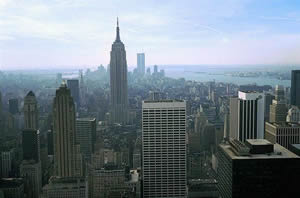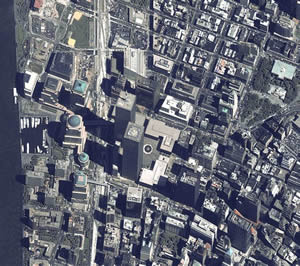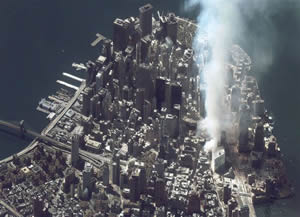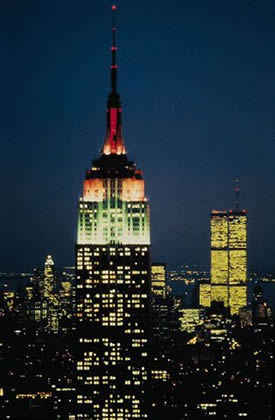In
Search of Silver Linings
Six months since September 11
September 11, will forever remain etched in the human psyche, as the most (in)famous date in our lifetimes. As we saw the towers collapse, in real-time; either on CNN or live with our own eyes, what took place that day, completely changes the way we take the world for granted.
For most Americans alive today, this was their first experience of an external attack on their homeland, and it shook them to the roots. It made them realize for once what it means to live day in and day out in fear, be it in Srinagar, India or Jerusalem, Israel, or Sarajevo, Bosnia-Herzegovena.
 |
The emanating damage and destruction from the attacks, transformed one of the most
dense pieces of downtown real estate in the world. Thirty years ago in a bombastic display of modernistic urban design, the World Trade Centre was carved out as a behemoth city superblock by combining nine smaller blocks and truncating six urban streets. The Twin Towers of the World Trade Centre became the landmark icon of the Big Apple, the physical enormity that the New Yorker loved to hate and hated to love. Of course that changed post September 11, when in its passing away, the Towers became the everlasting symbol of the city, a feat they could not achieve in their nearly three decade life.
The remains of the World Trade Centre take a circuitous route as they are carried away from ground zero. Larger building fragments are diverted to recycling plants in the region. At the plants the scrap is recycled into industrial grade metal. The long steel beams are cut into pieces, scrubbed of their burn marks, cleaned of stray concrete and then sold at a few cents a pound to steel companies in countries such as India, China, Turkey and Venezuala. Media reports state that the metal may be environmentally hazardous, due to asbestos and concrete contamination, and the federal agency in the US, deems it misfit for use in the USA. But of course they have no scruples when it comes to dumping this metal into third world nations. Even as you read this article, steel is being off loaded at Chennai and Kakinada, bound for steel plants in northern and eastern India. No environmental guidelines seem to be in force from the Government of India, and thus what is hazardous for one person, suddenly becomes a lucrative business deal for another.
With a very American alacrity, artists and architects began to propose September 11 memorials and post-terror master plans, within a week of the atrocity. Before a single bomber had crossed over into Afghan airspace, symbolic gestures, aimed towards "closure" were leaving drawings boards across New York City and the rest of America. The first memorial; the ephemeral Towers of Light designed by local artists Julian LaVerdiere and Paul Myoda, graced the cover of the TIME Magazine of September 23rd, 2001; nearly six months before the actual installation was inaugurated to celebrate the six month anniversary of the tragedy. As imposing as they stand out in the spring New York Skyline, they somehow highlight the absence of the towers they are meant to symbolize.
Various interest groups, city and nationwide went ahead with schemes to generate architectural and urban design dialogue, as soon as possible. For many it was a genuine concern to try to find a solution to the "wound" that had opened up the fabric of the city. For others it was a misplaced ideal to get some sort of publicity. For still others it was an urgency to see that the mistakes of the past, vis-à-vis planning and design are not repeated.
 |
At the opposite end of the architectural spectrum, a quarterly NYC magazine, the City Journal, commissioned the architecture firm of Frank Lohsen McCrery of Washington and the Scottish monumental sculptor Alexander Stoddart to design a rebuilt World Trade Centre site; for which they proposed a central sunken greensward surrounded by monumental sculptures, allegorical figures of history and memory facing a firefighter and a policeman.
Many such ideas have come up in the media, in the days hence. One idea that has found sudden widespread support; preserving the shattered 15 storey remnant of the South Tower, so memorable as a backdrop to photography! Understood as a ruin among the garden of a future memorial park, the notion of saving the fragment has ample precedent, but the idea has several risks. It elevates architecture above human lives, and makes a showpiece of something that was turned into an instrument of death. It collectivizes deaths in a time and place where the individual is paramount. And it flirts with aestheticizing mass murder. In this as well as other similar proposals, the question remains; that can a fragment of the twin towers adequately commemorate the disaster and if so then - Why - remains unanswered.
The city and the various federal agencies collaborating under one umbrella organization have got into action and formulated a timetable for the short term interventions and the long term visions for the site. Marilyn Jordan Taylor, urban designer and the CEO of Skidmore, Owings and Merrill, one of the two collaborative firms, entrusted with proposal master plan for the site elaborated the design process recently in a lecture, in New York City. The most demanding task as of now is for the infrastructure to be brought up and running. The regional transport hub for the NJ Transit and NYC Subway system lay under the collapsed towers and have been out of action since September 11. Marilyn urges that the biggest challenge facing her design team is to get the infrastructure design proposal in place, as soon as possible, while at the same time allowing for flexibility for the larger master plan and urban design vision which shall take longer to develop.
 |
The events of September 11 thrust the architectural profession in the United States and all over the world into a strange spotlight. Suddenly people were very interested in architecture, but not in the way most architects would hope. Questions about tall buildings abound. What makes them stand? What makes them fall down? Will I be safe in one??
Building codes in America have followed reactive and not proactive evolutionary path since the middle of the 20th Century, and are finally looking at a complete revamp and overhaul. European guidelines which were completely overhauled post WWII, are being used as the model for the new guidelines in the US.
Real estate development in a slow economy complicates the matters. Architects have long argued that architecture is a powerful cultural symbol with a value that transcends simple real estate calculations. The Trade Centre terrorists proved that point with horrifying speed and finality. Yet in the aftermath, the idea of encouraging "landmark" buildings suddenly becomes distasteful, even irresponsible.
Very few people were watching when the World Trade Centre was built. Everyone was watching when it was unbuilt. Everyone will still be watching as the property is redeveloped. It may be discomfiting to think of this tragedy in terms of "opportunity," but to deny that it exists would be disingenuous-and foolhardy. The Trade Center's reconstruction presents an extraordinary opportunity for the architectural community to reassert the leadership it once held in city-making.
Cities rebuild after disaster. But the most significant recent examples-London after World War II, and Berlin after reunification-are hardly reassuring. Postwar architects have largely failed to prove themselves on large, blank-slate sites, whether they ascribe to the assumptions of modernism, neotraditionalism, or something in between.
 |
The World Trade Center site is also large, particularly in the dense urban fabric of downtown Manhattan. Before it became a symbol of injustice, the Trade Center was a symbol of insensitivity, the kind of block- and scale-busting project that undermined the public's confidence in architects' ability to create good urban places. Cesar Pelli and others spent years trying to humanize the Trade Center's gigantic towers and flat-footed planning.
Architects have an enormous, era-defining responsibility in front of them on the Trade Center site. Already there promising signs that architects are beginning to respond proactively-and cooperatively-to situations that affect their place in the building process. That may be one of the great silver linings in the terrible cloud that settled over New York on September11.
In conclusion I would like to share a personal comment from Prof. H Masud Taj, Architect and Poet, in an email tome.
Prof Taj writes "Life is precious. In a world of increasing uncertainty we must not take our life-span for granted. The only gaurantee we have is the present moment. We have to learn to live intensly in the present tense. The architectural void will be filled I am sure - either by a memorial or another spectacular hi-rise. It is the thousands of talented individuals that worked at WTC that are irreplacable. My heart goes out for their families."
Arzan Sam Wadia, [[email protected]]
graduated with a Bachelors of Architecture from the Rizvi College of Architecture,
Bombay, India and after a brief professional stint in Graz, Austria, got
his Masters in Urban Design from the Pratt Institute, New York, He currently
practices in New York City.